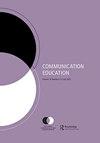混合建模:一种以人为中心的沟通和学习研究方法
IF 0.8
Q3 COMMUNICATION
引用次数: 0
摘要
教学交际学者传统上采用过程-产品范式来评估教师交际行为与学生学习成果之间的关系(Cortez等,2006)。这一传统范式催生了许多关于有效教学的基础性研究。同时,这种方法可能被恰当地描述为狭隘,因为它淡化了这样一个事实,即学生是独特的学习者,他们有自己的角色、责任、动机和能力(等等),这些都是他们带到学习环境中的。从本质上讲,这种过程-产品方法是有限的,因为它过分强调了有效教学的重要性,无论是主要的还是一般的,以相同的方式为所有学生培养相同的学习成果(有效的教学被认为是所有学生学习的结果,尽管他们是独一无二的)。从统计学上讲,过程-产品学术通常使用一般的线性模型(例如,相关性、t检验、方差分析、普通最小二乘回归)来检验交流和学生学习的关系。当学者们将交流变量与学习变量联系起来时,这种范式采取了一种以变量为中心的方法。采用以变量为中心的方法是这门学科的基础,但它假设样本中的学生属于单一群体。假设学生来自同质群体,对交流和/或学习关联产生单一参数估计;也就是说,在一项研究中,一个统计估计足以满足所有学生的需求。例如,如果估计的相关性为r = 0.30,则暗示这是总体中所有学生的相关性。类似地,在验证性因子分析中,如果因子负荷为λ = .88,则这是每个人的估计因子负荷。以变量为中心的方法通过提供描述所研究变量之间关系的单一估计,将重点放在变量而不是人身上。或者,通过有限混合建模的应用,分析焦点可以从变量转移到人,这为研究交流和学习提供了一种以人为本的方法。与以变量为中心的方法不同,以人为中心的方法允许种群异质性,因为样本体现了同质亚种群的未知混合。在混合建模的真正应用(直接应用)中,目标是发现潜在的问题本文章由计算机程序翻译,如有差异,请以英文原文为准。
Mixture modeling: a person-centered approach to studying communication and learning
Instructional communication scholars have traditionally adopted a process-product paradigm to estimate how teacher communication behaviors associate with student learning outcomes (Cortez et al., 2006). This traditional paradigm has generated much foundational research on effective teaching. At the same time, this approach might be appropriately described as narrow because it deemphasizes the fact that students are unique learners with their own roles, responsibilities, motivations, and abilities (and so on) that they bring into their learning environments. Substantively speaking, this process-product approach is limited because it overemphasizes the importance of how effective teaching, both principally and generally, fosters the same learning outcomes for all students in the same way (effective teaching is assumed to result in learning for all students despite their uniqueness in who they are). Statistically speaking, process-product scholarship typically examines communication and student learning relationships using the general linear model (e.g., correlation, t-test, analysis of variance, ordinary least-squares regression). This paradigm takes a variablecentered approach when scholars associate communication variables with learning variables. Taking a variable-centered approach has been foundational to the discipline, but it assumes that students from a sample belong to a single population. Assuming that students come from a homogeneous population yields a single parameter estimate for a communication and/or learning association; that is, one statistical estimate will suffice for all students in a study. For instance, if an estimated correlation is r = .30, it is implied that this is the correlation for all students in the population. Similarly, in confirmatory factor analysis, if a factor loading is λ = .88, this is the estimated factor loading for everyone. A variable-centered approach places the emphasis on variables rather than people by providing single estimates that describe relationships between variables under study. Alternatively, the analytical focus can be shifted from variables to people through the application of finite mixture modeling which offers a person-centered approach to studying communication and learning. Unlike a variable-centered approach, a person-centered approach allows for population heterogeneity to the extent that the sample embodies an unknown mixture of homogeneous subpopulations. In the truest application of mixture modeling (a direct application), the goal is to uncover latent
求助全文
通过发布文献求助,成功后即可免费获取论文全文。
去求助
来源期刊

COMMUNICATION EDUCATION
EDUCATION & EDUCATIONAL RESEARCH-
CiteScore
3.10
自引率
34.80%
发文量
47
期刊介绍:
Communication Education is a peer-reviewed publication of the National Communication Association. Communication Education publishes original scholarship that advances understanding of the role of communication in the teaching and learning process in diverse spaces, structures, and interactions, within and outside of academia. Communication Education welcomes scholarship from diverse perspectives and methodologies, including quantitative, qualitative, and critical/textual approaches. All submissions must be methodologically rigorous and theoretically grounded and geared toward advancing knowledge production in communication, teaching, and learning. Scholarship in Communication Education addresses the intersections of communication, teaching, and learning related to topics and contexts that include but are not limited to: • student/teacher relationships • student/teacher characteristics • student/teacher identity construction • student learning outcomes • student engagement • diversity, inclusion, and difference • social justice • instructional technology/social media • the basic communication course • service learning • communication across the curriculum • communication instruction in business and the professions • communication instruction in civic arenas In addition to articles, the journal will publish occasional scholarly exchanges on topics related to communication, teaching, and learning, such as: • Analytic review articles: agenda-setting pieces including examinations of key questions about the field • Forum essays: themed pieces for dialogue or debate on current communication, teaching, and learning issues
 求助内容:
求助内容: 应助结果提醒方式:
应助结果提醒方式:


